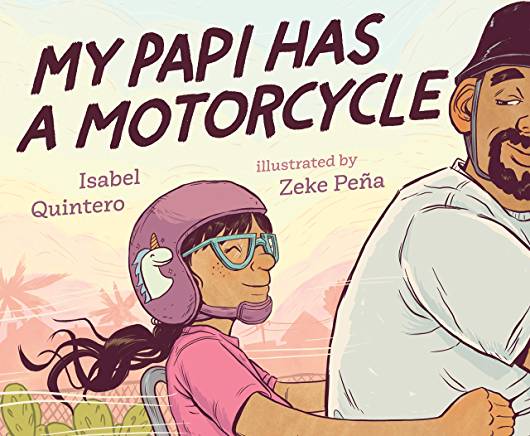I loved My Papi Has A Motorcycle by Isabel Quintero and Zeke Peña. Young Daisy has an amazing, affirming relationship with her construction worker Papi. As they zoom through the city we see her connection to the past, present, and tight-knit extended family. Without it being a topic of the book, we also notice signs of gentrification both good and bad providing a window for classroom discussion.
Zeke Peña’s mix of panels and traditional picture book illustrations are engaging. His muted palette has a vaguely southwestern feel without specifying a particular place. The landscape orientation allows the city to sprawl out for us. His use of watercolor and digital art and inset panels add visual interest to the pages. The mix of text and speech bubbles allow more characters a voice in the story. All text is in English though speech bubbles and illustration art is a mixture of Spanish and English reflecting the bilingual nature of Daisy’s world. A love that the lettering, sometimes at an angle adds to perspective. Endpapers give us a distant view of the community we saw up close on the ride.
Two illustrations stood out to me. I loved the vibrant colors of the motorcycle glowing in the sun as she begins her ride. The second stand out moment was late in the book when Peña chose not to continue with the double-page spreads we had on every other page of the story and instead we encounter a shop that has gone out of business. In that case, we see the closed shop on the left-hand side of the page and a large shaved ice treat that she wishes she was getting from there today dominating the right-hand side.
Spanish language incorporated in story and art can be translated through context clues.
I believe Peña’s work makes this story a contender for the 2020 Caldecott Award and a wonderful text for trying your hand at using Megan Dowd Lambert’s Whole Book Approach sharing this love letter on the story rug.

